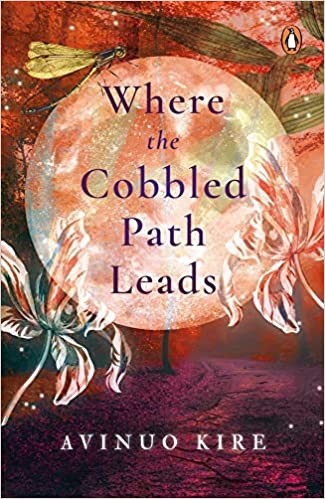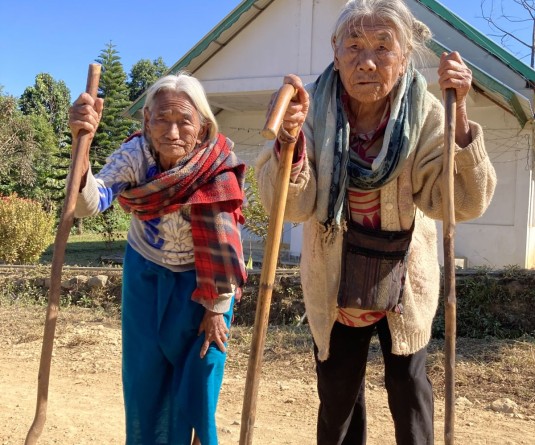
Dr. Vizovono Elizabeth
Independent researcher & freelance editor
Publisher: Hamish Hamilton, an imprint of Penguin Random House, India
Pages: 174, MRP: 499
Avinuo Kire’s debut novel Where the Cobbled Path Leads is an enchanting tale that takes the readers on a journey to the otherworldly. The book is about grief, love, learning to let go and growing up, as much as it is also about an exploration of Naga spiritual beliefs. Set in Kohima circa the 50s & 60s, it is the story of Vime, an 11 year old girl who is still grieving and struggling to move on a year after the death of her mother. The arrangement for her father’s second marriage to Khrielie, a much younger woman, is what sets the plot into action. Vime feels hurt and betrayed as her father and elder sister Neime seem to have moved on too soon. Her sadness leads her to find comfort away from others, walking down her favourite cobbled footpath that leads into the woods, where she encounters Kijűbode and Tei. Thereon the plot progresses as she battles her inner conflict in the spirit realm.
Kire is no stranger to the rich repository of Naga folk tradition. She is an ardent chronicler of oral narratives, transferring and infusing them into her creative narratives. Perhaps the most prolific among the emerging contemporary writers from Nagaland, Kire writes poetry, short stories and oral narratives. She has to her credit a collection of poetry, Where Wildflowers Grow (Barkweaver; 2015), an anthology of oral narratives People Stories: Volume One (PenThrill; 2016) that she co-authored with Meneno Vamuzo Rhakho, two collections of short stories - The Power to Forgive and Other Stories (Zubaan; 2016) and The Last Light of Glory Days (Speaking Tiger; 2021). Her more recent publications reflect her increasing allure with the indigenous sources of oral stories. But she has raised the bar higher with this novel, exploring further and more in depth with a subject that has been a constant theme in her creative writing.
Not so long ago at a Writers Collective meet in Kohima, Kire read a small passage from her soon to be published book. It was the part that describes the cobbled pathway leading to the portal into the beyond. As she stopped reading, I realized her narration had me imagining the entire scene in my mind. That is the mesmerizing power of her storytelling. It draws the reader (listener in this case) into her fictional world by the sheer creativity of her vivid imagination, manifested through words on the page. In Where the Cobbled Path Leads, she has created a fantastic fictional world of her own in her maiden venture as a novelist.
The events in the story unfold, engendered by Vime’s journey of going through the process of understanding grief, love, sacrifice, trust and acceptance. The subjective emotions metaphorically take on a concrete shape as Vime comes face to face with them, quite literally. And it is here that the narrative gains momentum. By introducing the concept of a portal to the ‘in-between,’ a realm that exists between the human world and what lies beyond, Kire waves her magic wand and the readers, along with Vime, tumble into the beyond, onto a journey to the masterfully crafted supernatural realm. The author’s choice of a child protagonist is accurate as it is only through a child’s perception that the fantastic elements can merge with lived reality, and become an actual reality without the need for the suspension of disbelief. This works perfectly as the lines between the human world and spirit world are blurred.
It also works on another level, presenting the indigenous Naga cosmology where these two realms have always coexisted and are accepted as part of our reality. Hence for the Naga reader, the supernatural elements are simultaneously realistic and fantastic. In one of her short stories “Longkhum” from the collection The Last Light of Glory Days, Kire writes,
“Our world is old. There are still places that spirits call home; where tired souls go to rest after their bodies have grown weary of living. Such lands lie somewhere between folklore and legend, at the turn of crossroads, tucked beneath the gentle veneer of civilization.”
And she continues, “They say Longkhum is where spirits of the dead go to rest before their final journey to paradise.” These lines, referring to an Ao folk belief, are like a prequel to the novel. They capture the essence of the main theme which is based on another Angami folk belief that excessive grieving after the passing of a loved one prevents the spirit of the dead from moving on to the afterlife. Or as Kijűbode explains to Vime, “Unrelenting bereavement is traitorous and easily exploited by mischievous spirits.” The ‘in-between’ is the realm where we find the spirits of people like Hevűsa and Vime’s mother, because their loved ones in the human world are still grieving. Fusing with such beliefs, it is a marvel how Kire also incorporates a plethora of many other Angami folk characters, beliefs and concepts such as Teikhrieruopfű, miawenuo, tekhumiavi, kijűbode, chűsenu and the like. The characterizations are very well done too. My personal favourites are Tei and the caretaker.
Vime goes to and from these two worlds, and the transitions provide the effect of contrast, adding more layers to the storytelling. In the human world, the author does not fail to present glimpses of the Indo- Naga conflict through Vime’s best friend Khriebu’s uncle who had joined the underground, was wanted by the Indian army, and finally leaves to undergo training in China or Pakistan. The themes therefore deal with universal human emotions but the story is quintessentially Naga –it depicts the Naga way of life which is now an amalgam of the contemporary and the traditional; indigenous spiritual belief and western Christianity; politics and armed conflict, all rolled into one.
The novel has been described as folk fantasy. But it also has elements of magic realism and cinematic fiction. The visual quality of the text, the camera-eye angle narration, the travelling, and techniques like zooms and pans provide a strong cinematic aura to the storyworld. Following is an example of zooming in for dramatic effect:
Gasping aloud, Vime instinctively winced as Tei made a rapid blink-and-you-miss lunging movement towards her. Vime felt a sudden gust of wind hit her but nothing happened. She opened her eyes to find no sign of Tei.
My favourite is when she pans out for a comprehensive effect. It was a delight to find the author herself using the word ‘panoramic.’ There are many memorable passages but I quote this to illustrate the technical acumen in crafting the narrative:
Imagine a panoramic view – a forbidden pre-creation forest as old as time, hostile trees rooted upon an earth which knew no laughter or sunshine, only bitter ghostly memories, all waiting to fulfill an ancient prophecy, and somewhere within this bleak emptiness, two young girls lying on their backs, hand in hand, as if on a gay picnic, lips delicately curved upwards, with tremulous tranquil smiles.
The author’s craft felt effortlessly strong in the scenes of the in-between. One can easily imagine this story being adapted into a movie.
The book is not without flaws though. I found some editing oversights, mostly typos. The descriptions were at times cluttered with wordiness. Kire is definitely a wordsmith and has a penchant for adverbs which she tends to use repeatedly within a single paragraph. Also, the use of local words alongside English in some of the expressions felt rather awkward. For instance, ‘Atsa, Grandmother,’ or ‘Mother, Apfo.’ The repetitions could’ve been done without, achieving a more authentic and natural speech pattern. Mrs. Sebu’s name with the English prefix seemed very odd as it didn’t fit in with the folk setting. But I do appreciate that the local words are not italicized; a choice the author herself has asserted that she insisted upon. It matters how a story is told, not just that the story is told. The minor glitches therefore, do not in any way take away the overall effect of the compelling narrative. I guess I’m just being picky because I wished this grand narrative of a book to be perfect.
Nevertheless, the magical quality of this must-read book is undeniable. Avinuo Kire has found her voice as a writer, a distinctive style that sets her apart from amongst the many emerging contemporary Naga authors. Where the Cobbled Path Leads is a refreshing and significant addition to the expanding literary landscape from the North east region and it would not be wrong to say that this debut novel firmly establishes her as the next indigenous Naga writer to look out for. It is just a matter of time before this literary talent achieves greater heights.




